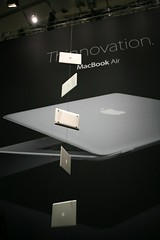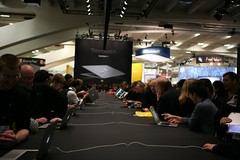Audible is one of the providers of exclusive audio content to Apple's iTunes store, as well as a provider to Amazon. In the battle for provider of downloadable content, Apple and Amazon are at odds with one another. While it would be a stupid decision for Amazon to discontinue Audible's partnership with Apple, it is a possible for Amazon to do so if they find it advantageous. All of which all begs the question: why didn't Apple buyout Audible? Audible's revenue stream coming from sales through Apple's iTunes store is around 25-30%, and with over a billion in cash reserves at Apple, $300 million seems to be a small price to pay for continued access to Audible content. The problem is not their content, but rather their profitability; Audible has lost money since its inception, a trend that is slowly turning around (their earnings per share last year was a mere negative 4 cents, and their estimated earnings per share for the current quarter is a whopping 2 cents).
Jobs has gone on record to say that people don't read anymore. Part of this statement might come from the news bit about the average American reading one book per year, but I think as audiobooks are a portion of the content being sold on iTunes, Jobs has some numbers on the the amount being sold by Apple of audio books, and my guess is those numbers are very small in comparison to the 4 billion songs sold on iTunes.
Part of the problem likely stems from the fact that online audiobooks are priced with variation much more than any other downloadable content on both Amazon or iTunes; a movie can be downloaded for 9.99, a song can be downloaded for 99 cents, and an audiobook can cost anywhere from 95 cents to 49.99. At those prices, most would likely rather purchase the paper and binding version of the book. Amazon's prices for downloadable audiobooks aren't much different from Apple's, most download books averaged within a few dollars of Apple's prices. The variance in price, as well as the somewhat limited selection (example: Harry Potter 6 can be found as an audio download on iTunes, but not on Amazon, and costs $49.99, while Harry Potter 7, the best-selling book of last year is not available at all).
If Amazon wants the Kindle to succeed, the content from Audible is a necessary to their future success; to Apple, audiobooks are nice to have, but not as necessary as the music is what dominates their iTunes store, and with prices as they are presently, it is unlikely that downloads of books in either e-book or audio form will ever overtake sales of physical books anytime soon.








